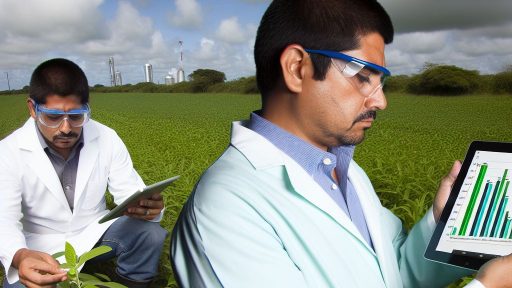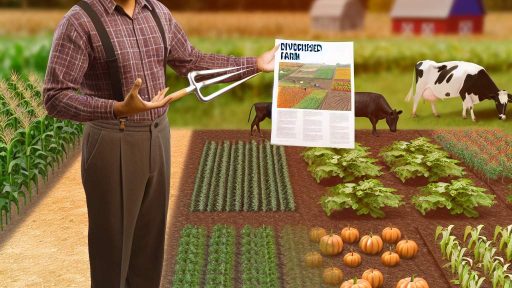Introduction to Sustainable Practices in Agriculture
Sustainable practices in agriculture focus on long-term farm viability.
Farmers today face rising costs, which pressures their operations.
Incorporating sustainable methods can significantly reduce these expenses.
These practices are not just environmentally friendly but also economically beneficial.
Understanding the Importance
Sustainability is crucial for farm health and the environment.
Healthy soil leads to better crop yields and lower costs.
Moreover, sustainable farming reduces reliance on chemical inputs.
Examples of Sustainable Practices
Crop rotation is a simple yet effective practice.
This technique improves soil fertility and reduces pest pressures.
Moreover, cover cropping helps prevent soil erosion and enhances organic matter.
Additionally, integrated pest management minimizes the need for harmful pesticides.
Benefits Beyond Cost Savings
Implementing sustainable practices fosters community support.
Consumers increasingly prefer products with eco-friendly credentials.
Supporting local ecosystems enhances resilience against climate change.
Understanding Agricultural Expenses
Breakdown of Costs
Agricultural expenses encompass several key areas.
Transform Your Agribusiness
Unlock your farm's potential with expert advice tailored to your needs. Get actionable steps that drive real results.
Get StartedFirstly, seed costs typically represent a significant portion of the budget.
Additionally, labor costs often add up quickly during peak seasons.
Machinery and equipment maintenance also incurs substantial expenses.
Furthermore, fertilizers and pesticides can greatly impact overall costs.
Finally, transportation and distribution costs should not be overlooked.
Factors Influencing Agricultural Expenses
Various factors affect agricultural expenses across different regions.
Climate conditions directly influence crop yields and related costs.
Market prices fluctuate, impacting both inputs and outputs.
Moreover, government policies can alter financial support or subsidies.
Technological advancements often drive initial expenses but can reduce costs over time.
Strategies for Managing Agricultural Expenses
Farmers can adopt several strategies to control their expenses.
Firstly, implementing crop rotation can enhance soil fertility.
Secondly, using integrated pest management reduces chemical dependency.
Additionally, establishing contracts with suppliers helps lock in prices.
Employing precision agriculture technologies can optimize input usage.
Finally, participating in cooperative purchasing can lower costs through bulk buying.
Implementing Crop Rotation to Improve Soil Health and Reduce Inputs
Basics of Crop Rotation
Crop rotation involves changing the type of crop grown in a particular area each season.
This method optimizes soil health and fertility.
Additionally, it helps break pest and disease cycles.
Farmers can thus reduce their reliance on chemical inputs.
Benefits of Crop Rotation
One significant benefit is enhanced soil structure.
Different root systems promote better soil aeration.
Moreover, diverse crops contribute various nutrients to the soil.
As a result, nutrient depletion is minimized over time.
Showcase Your Farming Business
Publish your professional farming services profile on our blog for a one-time fee of $200 and reach a dedicated audience of farmers and agribusiness owners.
Publish Your ProfileImproving Soil Nutrients
Leguminous crops, such as beans and peas, fix nitrogen in the soil.
This natural process enriches soil health effectively.
As a consequence, subsequent crops require fewer fertilizers.
Reducing Pest and Disease Incidence
By rotating crops, farmers disrupt pest life cycles.
Consequently, fewer pests can survive from one season to the next.
This strategy can diminish the need for pesticides.
How to Implement Crop Rotation
Start by assessing your current crop patterns.
Identify which crops are best to rotate based on soil health needs.
Next, develop a rotation schedule tailored to your farm.
Practice regular soil testing to gauge nutrient levels.
Creating a Rotation Plan
Your plan should include at least three different crop types.
Consider including cover crops for added benefits.
This approach prevents soil erosion and conserves moisture.
Monitoring and Adjusting
Regularly evaluate the effectiveness of your rotation plan.
Make adjustments based on changing crop performance and market trends.
Engaging with local agriculture extension services can also provide valuable insights.
Explore Further: Integrating Farm Activities With Visitor Experiences Effectively
Utilizing Cover Crops for Soil Fertility and Pest Control
Benefits of Cover Crops
Cover crops enhance soil fertility through natural processes.
They add organic matter to the soil, improving its structure.
Furthermore, these crops can help retain moisture, reducing irrigation needs.
In addition, cover crops can suppress weed growth effectively.
This minimizes the need for chemical herbicides in farming practices.
Types of Cover Crops
Pulses, such as clover and vetch, enrich the soil with nitrogen.
Spring grains like barley and oats prevent erosion and improve structure.
Winter cover crops retain soil moisture and prevent nutrient runoff.
They also offer habitat for beneficial insects throughout the year.
Implementation Strategies
Farmers should select cover crops based on local climate and soil type.
Planting should occur before the main crop for the best results.
Additionally, cover crops can be terminated before planting the cash crop.
This method maximizes their benefits while minimizing competition.
Pest Control Mechanisms
Some cover crops repel harmful pests naturally.
For instance, brassicas can deter nematodes and crop-damaging insects.
Moreover, diverse plantings attract beneficial insects for natural pest control.
This reduces the reliance on synthetic pesticides altogether.
Monitoring and Evaluation
Farmers should monitor soil health regularly to evaluate benefits.
Soil tests can provide insights into nutrient levels and organic matter.
Adjustments can be made based on observed changes in pest populations.
Continual evaluation helps optimize cover crop strategies over time.
Discover More: Implementing Data-Driven Decisions In Agriculture
Integrating Organic Fertilizers to Lower Chemical Costs
Understanding the Benefits of Organic Fertilizers
Organic fertilizers improve soil structure and fertility.
Showcase Your Farming Business
Publish your professional farming services profile on our blog for a one-time fee of $200 and reach a dedicated audience of farmers and agribusiness owners.
Publish Your ProfileThey promote microbial activity, which enhances nutrient cycling.
Additionally, they provide long-term benefits to soil health.
Types of Organic Fertilizers
Various types of organic fertilizers are available.
- Compost enriches soil with nutrients and beneficial microbes.
- Animal manure provides essential nutrients like nitrogen.
- Bone meal offers a rich source of phosphorus for plants.
- Green manure crops can enhance soil nitrogen levels naturally.
Cost-Effective Application Methods
Applying organic fertilizers can be cost-effective with proper methods.
Use soil tests to determine specific nutrient needs of crops.
Consider incorporating organic fertilizers into your crop rotation plan.
Also, side dressing plants with organic fertilizers can optimize absorption.
Collaborating with Local Suppliers
Partnering with local suppliers can reduce costs significantly.
Many local farms produce compost and manure at lower prices.
Additionally, sourcing locally reduces transportation costs and emissions.
Monitoring and Adjusting Fertilization Strategies
Regularly monitor soil health and crop growth for best results.
Adjust fertilization strategies based on crop responses and soil tests.
Continual adaptation ensures optimal use of resources and cost savings.
Discover More: Precision Agriculture Tools Enhancing Farm Productivity
Adopting Precision Agriculture Technologies for Efficient Resource Use
Understanding Precision Agriculture
Precision agriculture utilizes technology to optimize field variability.
This approach helps farmers make data-driven decisions.
Consequently, it improves crop yields and reduces costs.
Benefits of Implementing Precision Agriculture
Enhanced resource management is a significant benefit.
This technology allows for targeted water and fertilizer applications.
As a result, farmers achieve higher efficiency and lower expenses.
Utilizing Drones and Sensors
Drones provide aerial imagery for field analysis.
Farmers can monitor crop health in real-time using this technology.
Sensors placed in fields deliver precise soil and weather data.
Leveraging Data Analytics
Data analytics enables the interpretation of collected information.
Farmers can identify trends to improve future decisions.
This proactive approach supports sustainable farming practices.
Incorporating Variable Rate Technology
Variable rate technology allows for tailored inputs across fields.
Farmers adjust fertilizer and pesticide applications based on specific needs.
This method reduces waste and enhances overall productivity.
Training and Education
Education is crucial for effective technology use.
Farmers should invest in training programs to maximize benefits.
As a result, they can stay ahead in the evolving agricultural landscape.
Discover More: Enhancing Visitor Experience With Unique Agritourism Activities

Water Conservation Techniques
Drip Irrigation
Drip irrigation is an efficient method for delivering water directly to plant roots.
This technique minimizes water wastage and improves crop yields.
Farmers such as Clara Jennings have reported significant cost savings.
They utilize drip irrigation systems to reduce labor and energy expenses.
The system can be easily adjusted for various soil types and crops.
Additionally, it allows farmers to monitor moisture levels effectively.
As a result, it drastically reduces the risk of overwatering.
Showcase Your Farming Business
Publish your professional farming services profile on our blog for a one-time fee of $200 and reach a dedicated audience of farmers and agribusiness owners.
Publish Your ProfileFurthermore, drip irrigation promotes healthier plant growth.
Rainwater Harvesting
Rainwater harvesting captures and stores rainwater for agricultural use.
This technique can significantly decrease reliance on municipal water supplies.
Farmers like Raj Patel have adopted this method successfully.
They have set up collection systems that gather rainwater during storms.
This collected water provides a valuable resource during dry seasons.
Moreover, it reduces soil erosion and improves water quality.
It also offers an eco-friendly option for irrigation systems.
In addition, rainwater harvesting systems are relatively low-maintenance.
Combining Techniques for Best Results
Combining drip irrigation with rainwater harvesting maximizes resource efficiency.
This combination ensures consistent water availability throughout the season.
Farmers can thereby achieve increased crop productivity with lower costs.
Additionally, the integration of both systems promotes sustainability.
Thus, their combination offers resilience against climate variability.
Using both methods leads to a more stable agricultural environment.
Promoting Biodiversity to Enhance Ecosystem Services and Reduce Pesticide Use
The Importance of Biodiversity
Biodiversity plays a crucial role in farming ecosystems.
It contributes to soil health and productivity.
Moreover, diverse systems can withstand pests and diseases better.
Enhancing Ecosystem Services
Healthy ecosystems provide essential services to farmers.
These services include pollination, nutrient cycling, and pest control.
For instance, pollinators like bees support crop yields significantly.
Additionally, diverse plant species can attract beneficial insects.
Reducing Reliance on Pesticides
Using biodiversity can lower the need for chemical pesticides.
Natural predators help control pest populations effectively.
For example, ladybugs can reduce aphid numbers in crops.
Maintaining diverse ecosystems encourages a balanced environment.
Strategies to Promote Biodiversity
Farmers can adopt several strategies to boost biodiversity.
- Plant cover crops to enhance soil health.
- Implement crop rotation to diversify plant species.
- Create buffer zones with native plants around fields.
These practices can help maintain habitats for various organisms.
Case Studies of Successful Implementation
Several farms have successfully integrated biodiversity practices.
The Green Valley Farm reduced pesticide use by 30%.
They achieved this through cover cropping and habitat creation.
Similarly, Riverbend Organic Farm improved yields and reduced costs.
Benefits Beyond Costs
Incorporating biodiversity offers numerous benefits.
It improves resilience against climate change impacts.
Furthermore, it can lead to higher quality produce for consumers.
Ultimately, enhancing biodiversity supports sustainable agriculture.
Evaluating Government Programs and Incentives for Sustainable Farming
Understanding Available Programs
Numerous governments worldwide offer programs to support sustainable farming practices.
These initiatives seek to reduce costs and enhance environmental stewardship.
Farmers can access grants, loans, and technical assistance to sustain their operations.
Moreover, some programs provide financial incentives to adopt eco-friendly practices.
Showcase Your Farming Business
Publish your professional farming services profile on our blog for a one-time fee of $200 and reach a dedicated audience of farmers and agribusiness owners.
Publish Your ProfileGovernment Incentives
Incentives play a critical role in promoting sustainable agriculture.
Farmers can receive tax breaks for implementing renewable energy sources.
Additionally, subsidies are often available for purchasing organic seeds and fertilizers.
These financial supports encourage the transition to sustainable practices.
Examples of Successful Programs
The Conservation Reserve Program (CRP) exemplifies a successful government initiative.
This program pays farmers to convert environmentally sensitive land into conservation areas.
Similarly, the Environmental Quality Incentives Program (EQIP) assists farmers with sustainable practices.
These programs illustrate effective government support for eco-friendly agriculture.
Evaluating Program Effectiveness
Assessing the impact of programs is essential for their continued success.
Farmers should track improvements in yield and overall sustainability.
Moreover, transparency in program results fosters public trust and participation.
Regular evaluations help identify areas for enhancement in existing initiatives.
Engaging with Local Authorities
Farmers can benefit from collaboration with local governments and agencies.
Engaging with these bodies ensures farmers stay informed about available incentives.
Establishing relationships leads to tailored support for specific regional needs.
Furthermore, local workshops may provide valuable insights into sustainable practices.
The Long-term Benefits of Sustainable Practices on Costs
Cost Savings through Efficiency
Sustainable farming practices enhance operational efficiency.
By optimizing resource usage, farmers can significantly cut costs.
Crop rotation improves soil health and reduces the need for fertilizers.
Consequently, producers save on input costs in the long run.
Reduced Dependency on Chemicals
Employing organic farming methods decreases reliance on chemical inputs.
This shift leads to fewer expenses associated with pesticides and herbicides.
Ultimately, lower chemical use results in healthier crops and soil.
Over time, farmers see reduced expenditures and improved product quality.
Enhanced Soil Health
Sustainable practices focus on building soil fertility.
Healthy soil increases crop yields and reduces the need for artificial additives.
Moreover, it helps retain moisture, lowering irrigation costs.
Farmers investing in soil health reap significant financial rewards.
Increased Resilience Against Climate Variability
Sustainable methods improve farm resilience to climate impacts.
Practices like cover cropping protect against erosion and nutrient loss.
Consequently, this leads to more stable outputs year-round.
Farmers can maintain their income despite unpredictable weather conditions.
Long-term Viability for Future Generations
Investing in sustainable practices supports future farming endeavors.
It preserves resources for generations, ensuring ongoing productivity.
Additionally, sustainable methods protect the environment for future farmers.
Long-term thinking in agriculture leads to greater financial stability.
Additional Resources
Study suggests that climate smart agriculture can boost yields …
Towards nutrient neutrality: A review of agricultural runoff mitigation …




